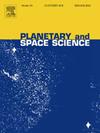Investigation of morphology and impact ejecta emplacement of the Copernican Das crater on the lunar farside
IF 1.7
4区 物理与天体物理
Q3 ASTRONOMY & ASTROPHYSICS
引用次数: 0
Abstract
This study investigates the morphology and ejecta emplacement dynamics of the Copernican-aged Das crater on the lunar farside. High-resolution panchromatic images, and spectral, and topographic data from lunar orbiter missions were utilized for the study. The identified morphological features in the crater such as central peaks, wall terraces, and impact melt deposits reflect how impact event interacted with the lunar surface. Based on our findings and existing knowledge of cratering processes, we discuss the stages in the evolution of the Das crater, involving excavation, rebound effects, wall collapse, and cavity modification. The impact melting that occurred during cavity modification significantly influences crater morphology and structural features such as central peaks and hummocky floor deposits. The effects of voluminous melting are also seen in the late-stage flow emplacement and rim veneers. Floor subsidence and structural adjustments, driven by extensive slumping and terrace formation, further shape the morphology of the crater. We propose a multi-stage process for ejecta emplacement during crater formation. The contiguous ejecta blanket forms via ballistic sedimentation in the excavation stage, followed by melt-ejecta emplacement in subsequent stages. The asymmetric distribution of ballistic ejecta around Das crater, notably the lack of secondary crater chains in the NNE direction, implied an oblique impact. This asymmetry, along with the circularity of the crater, indicated an impact direction from NNE to SSW, with an angle of 15°–25° relative to the horizontal. The crater elongation in the east-west direction results from post-impact modifications rather than the impact trajectory. The distribution of melt deposits is mainly concentrated in the eastern part of the crater, contrary to an expected downrange emplacement. This phenomenon is attributed to asymmetric cavity modification processes facilitated by pre-impact topographic asymmetry. Overall, these findings highlight the complex interplay between impact dynamics, topographic features, and post-impact modification processes in shaping the morphology of lunar craters, providing valuable insights into lunar surface evolution and impact cratering processes.
月球背面哥白尼陨石坑的形态和撞击抛射物位置研究
本研究研究了月球背面哥白尼时期达斯陨石坑的形态和喷出物就位动力学。这项研究利用了高分辨率全色图像,以及月球轨道飞行器任务的光谱和地形数据。在陨石坑中识别的形态特征,如中心山峰、壁梯田和撞击熔体沉积物,反映了撞击事件与月球表面的相互作用。根据我们的发现和现有的陨石坑过程知识,我们讨论了达斯陨石坑的演化阶段,包括挖掘、反弹效应、壁面坍塌和空洞改造。在空腔改造过程中发生的撞击熔化显著影响了陨石坑的形态和结构特征,如中心峰和丘状底沉积物。体积熔化的影响也见于后期流动就位和边缘贴面。在广泛的滑坡和阶地形成的驱动下,地面下沉和结构调整进一步塑造了陨石坑的形态。我们提出了一个多阶段的弹射物就位过程在火山口形成。在开挖阶段通过弹道沉积形成连续的喷出物层,随后在后续阶段形成融喷就位。达斯陨石坑周围弹道抛射物的不对称分布,特别是在NNE方向缺乏次级陨石坑链,暗示了一个斜撞击。这种不对称,加上陨石坑的圆形,表明撞击方向从北北偏南到南西,相对于水平方向的角度为15°-25°。陨石坑在东西方向上的延伸是由撞击后的变化而不是撞击轨迹造成的。熔体沉积物的分布主要集中在火山口的东部,与预期的向下就位相反。这种现象归因于撞击前地形的不对称性促进了不对称空腔的修饰过程。总的来说,这些发现强调了撞击动力学、地形特征和撞击后修改过程在形成月球陨石坑形态方面的复杂相互作用,为月球表面演化和撞击陨石坑过程提供了有价值的见解。
本文章由计算机程序翻译,如有差异,请以英文原文为准。
求助全文
约1分钟内获得全文
求助全文
来源期刊

Planetary and Space Science
地学天文-天文与天体物理
CiteScore
5.40
自引率
4.20%
发文量
126
审稿时长
15 weeks
期刊介绍:
Planetary and Space Science publishes original articles as well as short communications (letters). Ground-based and space-borne instrumentation and laboratory simulation of solar system processes are included. The following fields of planetary and solar system research are covered:
• Celestial mechanics, including dynamical evolution of the solar system, gravitational captures and resonances, relativistic effects, tracking and dynamics
• Cosmochemistry and origin, including all aspects of the formation and initial physical and chemical evolution of the solar system
• Terrestrial planets and satellites, including the physics of the interiors, geology and morphology of the surfaces, tectonics, mineralogy and dating
• Outer planets and satellites, including formation and evolution, remote sensing at all wavelengths and in situ measurements
• Planetary atmospheres, including formation and evolution, circulation and meteorology, boundary layers, remote sensing and laboratory simulation
• Planetary magnetospheres and ionospheres, including origin of magnetic fields, magnetospheric plasma and radiation belts, and their interaction with the sun, the solar wind and satellites
• Small bodies, dust and rings, including asteroids, comets and zodiacal light and their interaction with the solar radiation and the solar wind
• Exobiology, including origin of life, detection of planetary ecosystems and pre-biological phenomena in the solar system and laboratory simulations
• Extrasolar systems, including the detection and/or the detectability of exoplanets and planetary systems, their formation and evolution, the physical and chemical properties of the exoplanets
• History of planetary and space research
 求助内容:
求助内容: 应助结果提醒方式:
应助结果提醒方式:


